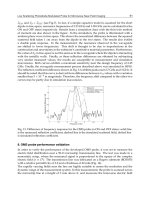Bioluminescence Recent Advances in Oceanic Measurements and Laboratory Applications Part 6 pptx
Bạn đang xem bản rút gọn của tài liệu. Xem và tải ngay bản đầy đủ của tài liệu tại đây (866.63 KB, 15 trang )
Bioluminescence – Recent Advances in Oceanic Measurements and Laboratory Applications
66
galactosidase, ubiquitin, dihydrofolate reductase, firefly luciferase, renilla luciferase,
Gaussia luciferase, etc.) have been adapted for split-protein strategies. Advantages of this
approach include its ability to monitor the interaction of proteins occurring in their
specific cellular compartments, utility for drug evaluation, low background, ability to
measure real-time interactions, applications in protein array analysis, and potential
adaptability to study both cells and in living animals. However, not every reporter protein
can be used for this strategy (Ozawa et al., 2001; Paulmurugan et al., 2004; Pelletier et al.,
1999; Remy and Michnick 1999; Rossi et al., 1997; Wehrman et al., 2002) (Figure 5).
Fig. 5. Scheme of a split-reporter protein complementation system for studying protein-
protein interactions. (A). Complementation system to study spontaneous protein-protein
interactions. In this strategy, N- and C- terminal firefly luciferase reporter protein fragments
are attached to two study proteins and are expressed as individual fusion proteins (N-
FLUC-Protein-X and Protein-Y-C-FLUC). When cells are transfected to co-express these two
fusion proteins, the interaction between protein-X and protein-Y brings the N-FLUC and C-
FLUC fragments to a close proximity and induces the complementation to produce reporter
signal. (B). Complementation system to study small molecule mediated protein-protein
interactions. In this strategy N- and C- terminal Renilla luciferase reporter protein
fragments are attached to two study proteins and are expressed as individual fusion
proteins (N-hRLUC-Protein-A and Protein-B-C-hRLUC). When cells are transfected to co-
express these two fusion proteins, the interaction between protein-A and protein-B is
induced by a small molecule drug, which brings the N-hRLUC and C-hRLUC fragments to a
close proximity and causes the complementation to produce reporter signal. In both
strategies, the amount of luciferase signals produced through complementation directly
relates to the interaction which occur between proteins X and Y or A and B (Paulmurugan
and Gambhir 2003; Paulmurugan et al., 2009).
Bioluminescent Proteins: High Sensitive Optical Reporters
for Imaging Protein-Protein Interactions and Protein Foldings in Living Animals
67
We made several combinations of N- and C- terminal fragments of the FLUC, RLUC, and
GLUC enzymes by a semi-rational dividing approach and used these fragments for protein-
protein interactions and protein folding studies. These fragments have been efficiently used
in complementation assays for the detection of insulin-mediated phosphorylation, as
gauged by the subsequent interaction of insulin receptor substrate peptide and its
interacting partner SH2 domain of PI-3kinase (Ozawa et al., 2001). They have also been used
to detect the interactions of the myogenic differentiation proteins Id and MyoD, in both cell
culture and non-invasive repetitive optical imaging in living mice (Paulmurugan et al.,
2002b). Separately, Luker et al., have also described a systematic truncation library yielding
alternative complementary N- and C- fragments of FLUC. These fragments were used to
monitor rapamycin-mediated interactions of rapamycin binding proteins (Luker et al., 2004).
We also have used our FLUC fragments to study Rapamycin-mediated interactions, and
found the complementation to be too weak for imaging in living animals by optical CCD
camera.
RLUC and GLUC are the smallest optical bioluminescent reporter proteins, and we have
identified several split sites for these proteins and found selective combinations that are
efficient for studying protein-protein interactions through a protein fragment
complementation strategy. This reporter protein, when rationally split (RLUC: between
residues 229 and 230 or 235 and 236; GLUC: between 105 and 106) (Paulmurugan and
Gambhir 2003), functions efficiently in both cell culture and in living animals, as we have
demonstrated with several different protein partners. Fragments generated by splitting
between residues 229 and 230 for RLUC and 105 and 106 for GLUC, were used to study
rapamycin-induced interactions of human proteins FRB (FKBP12 Rapamycin Binding
domain) and FKBP12 (FK506 Binding protein) (Paulmurugan et al., 2004), and also the
inherent homodimerization property of mutant HSV1-sr39TK (Massoud et al., 2004). One
limitation associated with the use of both RLUC and GLUC is their relatively rapid reaction
kinetics, requiring early time-point measurements (Bhaumik and Gambhir 2002a).
Nevertheless, this split reporter system appears highly suitable for studying protein-protein
interactions in cell culture and in living animals owing to its strong optical bioluminescence,
generating a signal that is amplifiable through an enzymatic process.
3.3 Bioluminescent reporter protein complementation assay to study protein folding
As we discussed in section 1.7, techniques for studying protein foldings are crucial in
measuring the functionality of important biologically active proteins. Several experimental
techniques are currently available for in vivo evaluation of protein folding within intact cells,
mainly relying on intramolecular fluorescence resonance energy transfer (FRET) (Morris et
al., 1982; Russwurm et al., 2007; Tsien 2009) of labeled residues or attached variants of green
fluorescent protein (GFP), but none of these techniques can be optimally extended to
imaging assays in intact living subjects. Protein complementation assays based on
bioluminescent reporters are highly sensitive in measuring not only protein-protein
interactions, they can also be efficiently used for studying protein foldings in intact cells and
in living animals by imaging. The application of protein complementation assays based on
bioluminescent reporters are more generalizable for measuring protein folding, but can be
used for imaging of protein folding in intact living subjects. The ability to detect, locate, and
quantify protein folding in the setting of a whole living animal model has important
Bioluminescence – Recent Advances in Oceanic Measurements and Laboratory Applications
68
implications: (1) to characterize the functional aspects of the fundamental process of protein
folding, including the study of biologically relevant and important factors, within realistic
and relatively undisturbed confines of cells that are also present in the midst of fully
functional and intact whole-body physiological environments; and (2) to accelerate the
evaluation in living animal models of emerging novel classes of drugs that promote folding
and conformational stability of proteins (e.g., those directed at the molecular chaperone heat
shock protein 90 (Hsp90)). Emerging strategies for molecular imaging of biological processes
in living small animal models of disease offer many distinct advantages over conventional
in vitro and cell culture experimentation.
In conclusion, we previously identified suitable split sites in the molecule of hRLUC that
generated an N- terminal 229-residue fragment (N-hRLUC) with minimal independent
activity and an inactive C- terminal 82-residue fragment (C-hRLUC) of the reporter protein.
Together, they were able to produce significant recovered activity through assisted
complementation. Later we used these reporter fragments along with reporter fragments of
firefly luciferase (FLUC) to test protein-protein interactions mediated in different
experimental settings: 1) proteins that spontaneously interact; 2) proteins that interact when
a small molecule is present; 3) protein-protein interactions that are blocked by small
molecules; 4) proteins-protein interactions that are mediated by phosphorylation; and 5)
protein hydroxylation that is mediated protein-protein interactions (Table 3). After a
thorough investigation of the system for studying protein-protein interactions, we
demonstrated that the normal conformational changes during protein folding, which result
in the close approximation of amino and carboxy termini of the proteins, can be measured
by using intramolecular complementation of correctly oriented chimeric split imaging
reporters in a strategy to detect, locate, time, quantify, and image protein folding in living
subjects. As we have extensively studied ligand induced estrogen receptor (ER) folding in
cells and in living animals, the following section will explain in detail the intramolecular
folding of ER in response to different steroidal and non-steroidal ligands in cells and in
living animals.
3.4 Protein complementation assays to study ligand- induced estrogen receptor
folding
Estrogens are responsible for the growth, development, and maintenance of the
reproductive, skeletal, neuronal, and immune systems as well as several other systems of
the body. The physiological effects of these hormones are mediated by the estrogen receptor
(ER), which is a ligand-inducible nuclear transcription factor (Tsai and O'Malley 1994). In
the classical pathway of steroid hormone action, 17β-estradiol (E2), hormones, and a variety
of other estrogens bind to the ligand-binding domain (LBD) of ER, leading to its
dimerization and subsequent binding to a specific regulatory sequence in the promoters of
ER target genes known as the estrogen response elements (Gronemeyer 1991; Schuur et al.,
2001) that then trigger activation or repression of many downstream target genes
(Brzozowski et al., 1997). The deficiency or excess of estrogens can lead to various
pathological conditions, including osteoporosis and breast carcinomas (Beck et al., 2005),
making ER a major cellular therapeutic target. ER activity in regulating target genes is
modulated by the binding of both steroidal and synthetic non-steroidal ligands. The ligand
Bioluminescent Proteins: High Sensitive Optical Reporters
for Imaging Protein-Protein Interactions and Protein Foldings in Living Animals
69
binding with ERs induces various conformations that control their interactions with
transcriptional co-regulators. Estrogen receptors (ERα and ERβ) regulate the expression of a
number of gene products required for the growth of cells in response to the endogenous
estrogen 17β-estradiol (E
2
). The crystal structures of ER ligand-binding domains (ER-LBDs)
complexed with different ER ligands provide useful insight into the design and synthesis of
new ligands. Although computer modeling and structure-based design can help predict
molecular interactions and structure-activity relationships, the pharmacological actions of
these ligands are unpredictable and require further biological evaluation. Thus, it remains
important to fully characterize nuclear hormone receptor ligands in cells and in animal
models before considering their use in humans. Several assay systems are currently
available to characterize ER ligands for their biological activity through ER in vitro and in
cell-based assays, but only a few can be directly extended for use in animals. We
approached this issue by using bioluminescence imaging to study estrogen biology in living
animals. Our system involves monitoring luminescence that derives from intramolecular
complementation of a split luciferase gene that is activated by ligand-induced folding of the
ER-LBD, and the responsiveness of various versions of this ligand sensor system to selected
ER ligands was validated in cellular systems.
Split-Reporter
Proteins
Imaging
Modality
Protein-
Protein
Interactions
Nature of interaction
Firefly Luciferase
(FLUC)
Bioluminescence Id/myoD Spontaneous interaction
Renilla Luciferase
(RLUC)
Bioluminescence FRB/FKBP12 Rapamycin mediated interaction
Gaussia Luciferase
(GLUC)
Bioluminescence
pVHL/HIF1-
Hydroxylation mediated interaction
Green Fluorescent
Protein (GFP)
Fluorescence Ras/Raf Phosphorylation mediated interaction
Red Fluorescent
Protein (RFP)
Fluorescence Hsp90/p23 Spontaneous interaction
Thymidine Kinase
(HSV1-TK)
PET p53/SV40-Tag Spontaneous interaction
ER/ER Estrogen mediated homodimerization
TK/TK Spontaneous dimerization
ER-Folding Estrogen mediated intramolecular
folding
IRS1/SH2 Phosphorylation mediated interaction
c-myc/GSK3
Phosphorylation mediated interaction
Table 3. List of optical and PET based split reporter complementation systems developed
and protein-protein interactions and protein foldings studied
The crystallographic studies with ER–LBD have shown that conformation of helix 12 (H12)
is critical in responses observed with various ER ligands (Brzozowski et al., 1997; Pike et al.,
2000; Shiau et al., 1998). The conformation of H12 behaves as a “molecular switch” that
Bioluminescence – Recent Advances in Oceanic Measurements and Laboratory Applications
70
either prevents or enhances the binding of ER to an array of co-activator proteins, which
then activates transcription of many downstream estrogen-regulated genes responsible for
cell growth. Given the critical role of H12 in ER signaling, we reasoned that it might be
feasible to develop an intramolecular ER folding sensor with specific split reporter
complementation patterns to study ligand pharmacology based directly on the
conformational changes of H12 in response to different ligands (Figure 6). We used a split
synthetic Renilla luciferase (RLUC) and Firefly luciferase (FLUC) complementation system,
which we previously developed and validated (Paulmurugan and Gambhir 2007;
Paulmurugan et al., 2002a), to test this hypothesis by assaying ligand-induced RLUC/FLUC
complementation in cell lysates, intact cells, and cell implants in living mice by noninvasive
bioluminescence optical imaging. The validated ER intramolecular folding sensors can also
be used to distinguish ligand pharmacology in cell culture studies and cell implants in
living animals treated with different ER ligands, agonists, selective ER modulators (SERMs),
and pure antiestrogens. In adapting this bioluminescence ER ligand sensor system for in vivo
use, we developed a version that contained a carefully developed single amino acid
Fig. 6. Schematic representation of the hypothetical model of ligand-induced intramolecular
folding of ER that leads to split firefly luciferase (FLUC) complementation. The N- and C-
terminal fragments of split-FLUC were fused to the N- and C- terminus, respectively, of the
hERα-LBD of various lengths (amino acids 281–549 or 281–595). Binding of ligands to the
LBD of ER in the intramolecular folding sensor (N-RLUC-hER-C-RLUC) induces different
potential folding patterns in the LBD based on ligands properties of potency and
biocharacter. This folding leads to split -FLUC complementation for ER antagonist/SERMS
(C), low complementation for ER agonist (A), and no complementation for partial ER
agonist/antagonist (B) with the selective folding sensor. Even though the distance between
the N- and C-FLUC fragments after binding with partial agonist (B) is smaller than that of
agonists (A), this model depicts the importance of the orientations of the split-FLUC
fragments in achieving complementation.
Bioluminescent Proteins: High Sensitive Optical Reporters
for Imaging Protein-Protein Interactions and Protein Foldings in Living Animals
71
mutation in the ERα-LBD, G521T. This ER mutant was selected to be essentially
unresponsive to E
2
, so that it could be used in mice without interference from the
endogenous ligand, while being responsive to certain non-steroidal estrogens such as
diethylstilbestrol (DES) and SERMs, making it possible to study their activity in vivo by
bioluminescence (Paulmurugan and Gambhir 2006; Paulmurugan et al., 2008).
We have developed and validated two hER intramolecular folding sensors that can be used
to distinguish ER ligand pharmacology. These receptor sensors can be directly translated
from cell culture studies to molecular imaging in small living subjects. In this study we used
an ER-based split reporter complementation strategy to follow the position of H12 within
the ER–LBD to detect changes in the receptor structural folding in response to ligand
binding. The longer construct with the F domain (281–595) appears ligand-pharmacology-
independent, whereas the shorter construct without the F domain (281–549) leads to the
highest levels of split luciferase complementation in response to SERMs, moderate levels for
agonists, and minimal levels for pure antiestrogens (Paulmurugan and Gambhir 2006). We
validated these intramolecular folding sensors with various ER ligands in both transiently
and stably transfected 293T kidney cells, and MDA-MB-231 (ER-negative) and MCF-7 (ER-
positive) breast cancer cells. To extend the folding sensor for applications in living animals,
we incorporated a previously undescribed mutant of hER (G521T) into the folding sensor
that was insensitive to circulating endogenous estrogen but retained its ability to distinguish
SERMs from synthetic agonists. Alternatively, ovariectomized mice can likely be used with
the wild-type hER with minimal competition from endogenous estrogens while retaining
the ability to study estrogen-like drugs.
To date, several in vitro assays have been developed for screening ER ligands by using either
purified ERα protein or ER isolated from cell lysates (Inoue et al., 1983; Krey et al., 1997;
Nasir and Jolley 1999; Nichols et al., 1998). Limited fluorescence-based assays (Zhou et al.,
1998) have been developed to measure receptor conformational changes (23) and
recruitment of coactivator peptides (Bai and Giguere 2003; Weatherman et al., 2002; Zhou et
al., 1998) in the full-length hERα within cell culture (Michalides et al., 2004). Other assays
have been designed to study the effects of synthetic ligands on ER transcription through the
activation of downstream target genes (Awais et al., 2004). However, most of these reported
assays are not suitable for quantitative, high-throughput screening of ER ligands in intact
cells and especially in living subjects through noninvasive molecular imaging. A
nontranscriptional assay containing fusion chimeras of either Flp recombinase (Logie et al.,
1998) or Cre recombinase (Kemp et al., 2004) with a truncated mouse ERα (amino acids 281–
599) has been reported and used for regulating the recombination of reporter genes in cells
and living animals. This system demonstrates high background activity even before the
addition of ER ligands, mainly through enzymatic amplification, thus limiting its dynamic
range in response to different ER ligands. We developed an analogous fusion chimera by
fusing a truncated version of hER (amino acids 281–595) with FLUC, which leads to
luciferase activity that is 10
4
-fold greater than background (mock-transfected cells) even
before the addition of ligands. To our knowledge, only one study has reported the
construction of mutant versions of hER (G521R and G521V) for selective ER ligand binding
using a fusion chimera containing hER
251–595
with Flp recombinase enzyme (28).
Incorporation of the same mutation into our intramolecular folding sensor (N-RLUC-hER
281–
595
-C-RLUC) led to nearly complete abolishment of signal for all ER ligands (hER
G521R
) and a
Bioluminescence – Recent Advances in Oceanic Measurements and Laboratory Applications
72
significant reduction in signal (77–89%) for all agonist activities (hER
G521V
) relative to wild
type hER. We constructed intramolecular folding sensors using the hER
G521
mutants with 19
different possible amino acids. We found that the replacement of hER
G521
with threonine
leads to nearly complete abolishment of the E2-induced RLUC complementation but only a
10–20% reduction for all other ER ligands studied. Subsequently, 293T cells stably
expressing this intramolecular folding sensor (N-RLUC-hER
281–549/G521T
-C-RLUC) were
generated for imaging hERα/ligand complexes in living animals.
The advantages of the intramolecular folding sensor strategy that has been developed and
validated include the following: (i) it is real-time (because RLUC exhibits flash kinetics) and
quantitative; (ii) it can be used to distinguish binding of agonists, SERMs, and pure
antiestrogens; (iii) it can be adapted for studying ligand binding to hER in living animal
models by molecular imaging, and thus pharmacokinetic properties of each drug/ligand
can be examined; (iv) it allows for a high-throughput strategy for screening/comparing
different ER ligands and drugs in multiple cell lines; (v) it allows direct transition from cell
culture studies to small living subjects because it is based on a bioluminescence split
reporter strategy; and lastly, (vi) it will allow for applications using transgenic models that
incorporate the intramolecular folding sensor. In addition, the availability of other split
reporters with different properties and substrate specificities should allow multiplexing
with other reporter assays.
The limitations with using split RLUC as the reporter gene regarding efflux of its substrate
coelenterazine were resolved by showing experiments that resulted in no significant relation
between the RLUC complementation and the multidrug resistance systems (Pichler et al.,
2004). In addition, the intramolecular folding system was also studied with the improved split
FLUC fragments by replacing RLUC fragments. Both systems showed equal sensitivity in
different cell culture experiments. The FLUC fragments showed more detectable signal in
mouse experiments than RLUC because of more light penetration through tissues, due to the
more red-shifted wavelengths of FLUC. Also, the FLUC-based folding system showed greater
efficiency in differentiating ER ligands in living mice. It is also possible that the exact locations
(cytosolic vs. nuclear) of our fusion reporter proteins may affect the results obtained, and this
will need to be explored in future studies. In addition, for some applications in vivo, the
developed strategies may have difficulty in distinguishing agonists from background, and this
potential problem needs to be investigated with testing of additional drugs.
3.5 Reporter protein complementations to monitor multi-protein interactions
The availability of multiple bioluminescent reporters (FLUC, RLUC, GLUC, and possibly
VLUC) can be easily adopted for studying multiple proteins involved in a cellular network
(e.g., Hsp90 chaperon multi-protein complex has more than 50 proteins) (Goetz et al., 2003)
by multiplexing reporter combinations. The use of multiple reporters not only provides the
interaction between more than two proteins, but can also provide more precise informations
to modulate the effect that one set of protein may exert on other sets of proteins involved in
the same complex. In addition, it can also be used to extract the distances among different
proteins involved in a complex based on the amount the complementation signals produced
from each set of proteins (Figure 7). We are actively exploring multi-protein interactions by
multiplexing several combinations, and we hope to soon publish results about this strategy
and its feasibility.
Bioluminescent Proteins: High Sensitive Optical Reporters
for Imaging Protein-Protein Interactions and Protein Foldings in Living Animals
73
Fig. 7. Schematic representation of two split-reporter complementation systems to detect the
interactions between several proteins involved in a multi-protein interaction complex. In
this strategy, the results of two reporter protein complementations measured
simultaneously between two reporters (Split-FLUC and Split-RLUC) induced by small
molecules can predict possible arrangements of different proteins involved in this complex
(Hsp90, p23, Estrogen Receptor, p53, and HDM2). Four different hypothetical models have
been proposed based on possible theoretical complementations by these reporters in
response to drugs which modulate Hsp90/p23 interaction (17AAG), p53/ER interaction
(E2), and p53/HDM2 interaction (Nutlin 3).
4. Bioluminescence resonance energy transfer
Bioluminescence Resonance Energy Transfer (BRET) technology involves the nonradioactive
transfer of energy between donor and acceptor molecules by the Förster mechanism (46). The
energy transfer primarily depends on the following: (1) an overlap between the emission and
excitation spectra of the donor (bioluminescence) and acceptor (Fluorophore or a fluorescent
protein) molecules, respectively; (2) the proximity of < 100 Å between the donor and the
acceptor entities; and (3) the conformational orientation light emission with the acceptance end
of the fluorescence entity. As BRET-based technology assumes more prominent roles in the
field of studying PPIs, many commercial vendors are developing new instrumentations for
measuring BRET ratios, which are generally low-intensity signals. BRET measurements are
usually obtained with a microplate reader equipped with specific filter sets for detection of the
donor and acceptor emission peaks. This cellular assay has been applied to real-time imaging
of cells, high-throughput screening of drugs, and small animal and plant models. There are
several combination of BRET involving Renilla luciferase and green fluorescent protein and
Firefly luciferase with variants of red fluorescent proteins developed for studying protein-
protein interactions. The BRET2 system (Biosignal Packard Montreal, Canada) using renilla
luciferase (RLUC) as a bioluminescent donor and mutant GFP2 as a fluorescent acceptor was
Bioluminescence – Recent Advances in Oceanic Measurements and Laboratory Applications
74
adapted for expression in mammalian cells and characterized by a significantly red-shifted
Stokes shift that emits transferred energy at 508 nm. The resonance energy transfer from the
reaction of the reconstructed RLUC protein with its substrate Deep Blue Coelenterazine (DBC)
excites the GFP2 protein, as the two fused proteins Id and MyoD, or FKBP12 and FRB which
interact in the presence of a small molecule mediator (rapamycin). Our lab also demonstrated
the ability to detect signal from PPIs in cultured cells, as well as from the surface and deeper
tissues of small living animals with implanted cells over expressing the fusion constructs (For
further details, read (De et al., 2009; Dragulescu-Andrasi et al., 2011).
Our lab has recently showed that the BRET2 assay sensitivity can be significantly improved
by using RLUC mutants with improved quantum efficiency and/or stability (eg, RLUC8
and RLUCM) as a donor. To extend the time of light measurement, we also developed
CLZ400 (also known as bisdeoxycoelenterazine) analogs, showing that signal from our
improved BRET2 vector can be monitored for up to 6 hours. This approach, currently
undergoing continuing validation, should have important implications for the study of PPIs
in cells maintained in their natural environment, particularly if it can be effectively applied
for the evaluation of new pharmaceuticals. Most recently, further advances in this field have
led us to develop a high photon efficiency, self-illuminating fusion protein combining a
mutant red fluorescent protein (mOrange) and a mutant RLUC (RLUC8). This new BRET
fusion protein (BRET3) exhibits a several fold improvement in light intensity in comparison
to existing BRET fusion proteins. BRET3 also exhibits the most red-shifted light output (564
nm peak wavelength) of any reported bioluminescence protein that uses its natural
coelenterazine substrate, a benefit that can be demonstrated at various tissue depths in small
animals.
5. Future directions in bioluminescence imaging
Molecular imaging has been recognized as an important and exciting area of bio-medical
research, mainly because of its ability to visually represent, characterize, and quantify
biological processes in living subjects. Techniques such as Positron Emission Tomography
(PET), Single-photon Emission Computed Tomography (SPECT), and Magnetic Resonance
Imaging (MRI) have been extensively used in the clinic for several diagnostic and disease
monitoring processes; all these systems explore intracellular proteins or other molecules as
probes for the signal. Reporter genes (Bioluminescence, fluorescence, and PET), on the other
hand, are capable of precisely monitoring sub-cellular processes and their native functional
actions in cells, and imaging them in living animals. Challenges, however, remain in
delivering these proteins in cells without perturbing the cellular microenvironments. Another
obstacle is in generating sufficient sensitivity to measure theses signals, especially in living
animals. Problems associated with the modulations in the cellular microenvironment are also
tricky, but may be minimized by expressing few copies and weighing the sensitivity. The
continuing development of new high-sensitivity instruments with tomographic imaging
capabilities and improved spatial resolutions will play an important role in expanding the
applications of bioluminescent reporters and exploiting their unique ability to precisely image
the sub-cellular processes in their native microenvironment.
6. References
Anfinsen CB. (1973). Principles that govern the folding of protein chains. Science Vol.181,
No.96:pp.223-230.
Bioluminescent Proteins: High Sensitive Optical Reporters
for Imaging Protein-Protein Interactions and Protein Foldings in Living Animals
75
Artemov D, Mori N, Ravi R, and Bhujwalla ZM. (2003). Magnetic resonance molecular
imaging of the HER-2/neu receptor. Cancer Res Vol.63, No.11:pp.2723-2727.
Awais M, Sato M, Sasaki K, and Umezawa Y. (2004). A genetically encoded fluorescent
indicator capable of discriminating estrogen agonists from antagonists in living
cells. Anal Chem Vol.76, No.8:pp.2181-2186.
Bai Y, and Giguere V. (2003). Isoform-selective interactions between estrogen receptors and
steroid receptor coactivators promoted by estradiol and ErbB-2 signaling in living
cells. Mol Endocrinol Vol.17, No.4:pp.589-599.
Beck V, Rohr U, and Jungbauer A. (2005). Phytoestrogens derived from red clover: an
alternative to estrogen replacement therapy? J Steroid Biochem Mol Biol Vol.94,
No.5:pp.499-518.
Becker T, Weber K, and Johnsson N. (1990). Protein-protein recognition via short
amphiphilic helices; a mutational analysis of the binding site of annexin II for p11.
Embo J Vol.9, No.13:pp.4207-4213.
Beeckmans S. (1999). Chromatographic methods to study protein-protein interactions.
Methods Vol.19, No.2:pp.278-305.
Bhaumik S, and Gambhir SS. (2002a). Optical imaging of Renilla luciferase reporter gene
expression in living mice. Proc Natl Acad Sci U S A Vol.99, No.1:pp.377-382.
Bhaumik S, and Gambhir SS. (2002b). Optical imaging of Renilla luciferase reporter gene
expression in living mice. Proc Natl Acad Sci USA Vol.99, No.1:pp.377-382.
Bhaumik S, Lewis XZ, and Gambhir SS. (2004). Optical imaging of Renilla luciferase,
synthetic Renilla luciferase, and firefly luciferase reporter gene expression in living
mice. J Biomed Opt Vol.9, No.3:pp.578-586.
Bode J, and Willmitzer. (1975). Application of fluorescamine to the study of protein-DNA
interactions. Nucleic Acids Res Vol.2, No.10:pp.1951-1965.
Brzozowski AM, Pike AC, Dauter Z, Hubbard RE, Bonn T, Engstrom O, Ohman L, Greene
GL, Gustafsson JA, and Carlquist M. (1997). Molecular basis of agonism and
antagonism in the oestrogen receptor. Nature Vol.389, No.6652:pp.753-758.
Burt BM, Humm JL, Kooby DA, Squire OD, Mastorides S, Larson SM, and Fong Y. (2001).
Using positron emission tomography with [(18)F]FDG to predict tumor behavior in
experimental colorectal cancer. Neoplasia Vol.3, No.3:pp.189-195.
Cherry SR, and Gambhir SS. (2001). Use of positron emission tomography in animal
research. Ilar J Vol.42, No.3:pp.219-232.
Contag CH, Jenkins D, Contag PR, and Negrin RS. (2000). Use of reporter genes for optical
measurements of neoplastic disease in vivo. Neoplasia Vol.2, No.1-2:pp.41-52.
Contag CH, and Ross BD. (2002). It's not just about anatomy: in vivo bioluminescence
imaging as an eyepiece into biology. J Magn Reson Imaging Vol.16, No.4:pp.378-387.
Contag CH, Spilman SD, Contag PR, Oshiro M, Eames B, Dennery P, Stevenson DK, and
Benaron DA. (1997). Visualizing gene expression in living mammals using a
bioluminescent reporter. Photochem Photobiol Vol.66, No.4:pp.523-531.
Contag PR, Olomu IN, Stevenson DK, and Contag CH. (1998). Bioluminescent indicators in
living mammals. Nat Med Vol.4, No.2:pp.245-247.
De A, Ray P, Loening AM, and Gambhir SS. (2009). BRET3: a red-shifted bioluminescence
resonance energy transfer (BRET)-based integrated platform for imaging protein-
protein interactions from single live cells and living animals. FASEB J Vol.23,
No.8:pp.2702-2709.
de Wet JR, Wood KV, Helinski DR, and DeLuca M. (1985). Cloning of firefly luciferase
cDNA and the expression of active luciferase in Escherichia coli. Proc Natl Acad Sci
U S A Vol.82, No.23:pp.7870-7873.
Bioluminescence – Recent Advances in Oceanic Measurements and Laboratory Applications
76
Dragulescu-Andrasi A, Chan CT, De A, Massoud TF, and Gambhir SS. (2011).
Bioluminescence resonance energy transfer (BRET) imaging of protein-protein
interactions within deep tissues of living subjects. Proc Natl Acad Sci U S A Vol.108,
No.29:pp.12060-12065.
Fernandez-Guinea O, Andicoechea A, Gonzalez LO, Gonzalez-Reyes S, Merino AM,
Hernandez LC, Lopez-Muniz A, Garcia-Pravia P, and Vizoso FJ. (2010).
Relationship between morphological features and kinetic patterns of enhancement
of the dynamic breast magnetic resonance imaging and clinico-pathological and
biological factors in invasive breast cancer. BMC Cancer Vol.10:pp.8.
Fields S, and Song O. (1989). A novel genetic system to detect protein-protein interactions.
Nature Vol.340, No.6230:pp.245-246.
Gambhir SS. (2002). Molecular imaging of cancer with positron emission tomography. Nat
Rev Cancer Vol.2, No.9:pp.683-693.
Goetz MP, Toft DO, Ames MM, and Erlichman C. (2003). The Hsp90 chaperone complex as
a novel target for cancer therapy. Ann Oncol Vol.14, No.8:pp.1169-1176.
Goldenberg DM, Preston DF, Primus FJ, and Hansen HJ. (1974). Photoscan localization of
GW-39 tumors in hamsters using radiolabeled anticarcinoembryonic antigen
immunoglobulin G. Cancer Res Vol.34, No.1:pp.1-9.
Goldenberg DM, and Sharkey RM. (2007). Novel radiolabeled antibody conjugates.
Oncogene Vol.26, No.25:pp.3734-3744.
Gronemeyer H. (1991). Transcription activation by estrogen and progesterone receptors.
Annu Rev Genet Vol.25:pp.89-123.
Hastings JW. (1996). Chemistries and colors of bioluminescent reactions: a review. Gene
Vol.173, No.1 Spec No:pp.5-11.
Hodges RA, Perler FB, Noren CJ, and Jack WE. (1992). Protein splicing removes intervening
sequences in an archaea DNA polymerase. Nucleic Acids Res Vol.20, No.23:pp.6153-
6157.
Hucho F, and Wallenfels K. (1972). Glucono- -lactonase from Escherichia coli. Biochim
Biophys Acta Vol.276, No.1:pp.176-179.
Inoue A, Yamakawa J, Yukioka M, and Morisawa S. (1983). Filter-binding assay procedure
for thyroid hormone receptors. Anal Biochem Vol.134, No.1:pp.176-183.
Jawhara S, and Mordon S. (2004). In vivo imaging of bioluminescent Escherichia coli in a
cutaneous wound infection model for evaluation of an antibiotic therapy.
Antimicrob Agents Chemother Vol.48, No.9:pp.3436-3441.
Johnsson N, and Varshavsky A. (1994a). Split ubiquitin as a sensor of protein interactions in
vivo. Proc Natl Acad Sci U S A Vol.91, No.22:pp.10340-10344.
Johnsson N, and Varshavsky A. (1994b). Ubiquitin-assisted dissection of protein transport
across membranes. Embo J Vol.13, No.11:pp.2686-2698.
Jung JC, and Schnitzer MJ. (2003). Multiphoton endoscopy. Opt Lett Vol.28, No.11:pp.902-904.
Kemp R, Ireland H, Clayton E, Houghton C, Howard L, and Winton DJ. (2004). Elimination
of background recombination: somatic induction of Cre by combined
transcriptional regulation and hormone binding affinity. Nucleic Acids Res Vol.32,
No.11:pp.e92.
Kippen AD, and Fersht AR. (1995). Analysis of the mechanism of assembly of cleaved
barnase from two peptide fragments and its relevance to the folding pathway of
uncleaved barnase. Biochemistry Vol.34, No.4:pp.1464-1468.
Krey G, Braissant O, L'Horset F, Kalkhoven E, Perroud M, Parker MG, and Wahli W. (1997).
Fatty acids, eicosanoids, and hypolipidemic agents identified as ligands of
Bioluminescent Proteins: High Sensitive Optical Reporters
for Imaging Protein-Protein Interactions and Protein Foldings in Living Animals
77
peroxisome proliferator-activated receptors by coactivator-dependent receptor
ligand assay. Mol Endocrinol Vol.11, No.6:pp.779-791.
Levinthal C. (1969). "How to Fold Graciously". Mossbauer Spectroscopy in Biological
Systems: . Proceedings of a meeting held at Allerton House, Monticello, Illinois: 22–24.
Logie C, Nichols M, Myles K, Funder JW, and Stewart AF. (1998). Positive and negative
discrimination of estrogen receptor agonists and antagonists using site-specific
DNA recombinase fusion proteins. Mol Endocrinol Vol.12, No.8:pp.1120-1132.
Loontiens FG, Wallenfels K, Weil R, and Massart EL. (1970). [Interaction between
"Escherichia coli" beta-galactosidase and O-mercuriphenyl beta-D-galactoside
chloride, an unexpected substrate]. Arch Int Physiol Biochim Vol.78, No.3:pp.596-597.
Lorenz WW, Cormier MJ, O'Kane DJ, Hua D, Escher AA, and Szalay AA. (1996). Expression
of the Renilla reniformis luciferase gene in mammalian cells. J Biolumin Chemilumin
Vol.11, No.1:pp.31-37.
Lorenz WW, McCann RO, Longiaru M, and Cormier MJ. (1991). Isolation and expression of
a cDNA encoding Renilla reniformis luciferase. Proc Natl Acad Sci U S A Vol.88,
No.10:pp.4438-4442.
Luker GD, Sharma V, Pica CM, Dahlheimer JL, Li W, Ochesky J, Ryan CE, Piwnica-Worms
H, and Piwnica-Worms D. (2002a). Noninvasive imaging of protein-protein
interactions in living animals. Proc Natl Acad Sci U S A Vol.99, No.10:pp.6961-6966.
Luker GD, Sharma V, Pica CM, Dahlheimer JL, Li W, Ochesky J, Ryan CE, Piwnica-Worms
H, and Piwnica-Worms D. (2002b). Noninvasive imaging of protein-protein
interactions in living animals. Proc Natl Acad Sci U S A Vol.99, No.10:pp.6961-6966.
Luker GD, Sharma V, Pica CM, Prior JL, Li W, and Piwnica-Worms D. (2003). Molecular
imaging of protein-protein interactions: controlled expression of p53 and large T-
antigen fusion proteins in vivo. Cancer Res Vol.63, No.8:pp.1780-1788.
Luker KE, Smith MC, Luker GD, Gammon ST, Piwnica-Worms H, and Piwnica-Worms D.
(2004). Kinetics of regulated protein-protein interactions revealed with firefly
luciferase complementation imaging in cells and living animals. Proc Natl Acad Sci
U S A Vol.101, No.33:pp.12288-12293.
Luo Y, Batalao A, Zhou H, and Zhu L. (1997). Mammalian two-hybrid system: a
complementary approach to the yeast two-hybrid system. Biotechniques Vol.22,
No.2:pp.350-352.
MacDonald SM, Harisinghani MG, Katkar A, Napolitano B, Wolfgang J, and Taghian AG.
(2010). Nanoparticle-enhanced MRI to evaluate radiation delivery to the regional
lymphatics for patients with breast cancer. Int J Radiat Oncol Biol Phys Vol.77,
No.4:pp.1098-1104.
Massoud TF, and Gambhir SS. (2003). Molecular imaging in living subjects: seeing
fundamental biological processes in a new light. Genes Dev Vol.17, No.5:pp.545-580.
Massoud TF, Paulmurugan R, and Gambhir SS. (2004). Molecular imaging of homodimeric
protein-protein interactions in living subjects. Faseb J Vol.18, No.10:pp.1105-1107.
Massoud TF, Paulmurugan R, and Gambhir SS. (2010). A molecularly engineered split
reporter for imaging protein-protein interactions with positron emission
tomography. Nat Med Vol.16, No.8:pp.921-926.
Mehta AD, Jung JC, Flusberg BA, and Schnitzer MJ. (2004). Fiber optic in vivo imaging in
the mammalian nervous system. Curr Opin Neurobiol Vol.14, No.5:pp.617-628.
Michalides R, Griekspoor A, Balkenende A, Verwoerd D, Janssen L, Jalink K, Floore A,
Velds A, van't Veer L, and Neefjes J. (2004). Tamoxifen resistance by a
conformational arrest of the estrogen receptor alpha after PKA activation in breast
cancer. Cancer Cell Vol.5, No.6:pp.597-605.
Bioluminescence – Recent Advances in Oceanic Measurements and Laboratory Applications
78
Michnick SW. (2001). Exploring protein interactions by interaction-induced folding of
proteins from complementary peptide fragments. Curr Opin Struct Biol Vol.11,
No.4:pp.472-477.
Mintun MA, Welch MJ, Siegel BA, Mathias CJ, Brodack JW, McGuire AH, and
Katzenellenbogen JA. (1988). Breast cancer: PET imaging of estrogen receptors.
Radiology Vol.169, No.1:pp.45-48.
Morris SJ, Sudhof TC, and Haynes DH. (1982). Calcium-promoted resonance energy transfer
between fluorescently labeled proteins during aggregation of chromaffin granule
membranes. Biochim Biophys Acta Vol.693, No.2:pp.425-436.
Nasir MS, and Jolley ME. (1999). Fluorescence polarization: an analytical tool for
immunoassay and drug discovery. Comb Chem High Throughput Screen Vol.2,
No.4:pp.177-190.
Nichols JS, Parks DJ, Consler TG, and Blanchard SG. (1998). Development of a scintillation
proximity assay for peroxisome proliferator-activated receptor gamma ligand
binding domain. Anal Biochem Vol.257, No.2:pp.112-119.
Nichtl A, Buchner J, Jaenicke R, Rudolph R, and Scheibel T. (1998). Folding and association
of beta-Galactosidase. J Mol Biol Vol.282, No.5:pp.1083-1091.
Ntziachristos V, Tung CH, Bremer C, and Weissleder R. (2002). Fluorescence molecular
tomography resolves protease activity in vivo. Nat Med Vol.8, No.7:pp.757-760.
Ozawa T, Kaihara A, Sato M, Tachihara K, and Umezawa Y. (2001). Split luciferase as an
optical probe for detecting protein-protein interactions in mammalian cells based
on protein splicing. Anal Chem Vol.73, No.11:pp.2516-2521.
Paulmurugan R, and Gambhir SS. (2003). Monitoring protein-protein interactions using split
synthetic renilla luciferase protein-fragment-assisted complementation. Anal Chem
Vol.75, No.7:pp.1584-1589.
Paulmurugan R, and Gambhir SS. (2006). An intramolecular folding sensor for imaging
estrogen receptor-ligand interactions. Proc Natl Acad Sci U S A Vol.103,
No.43:pp.15883-15888.
Paulmurugan R, and Gambhir SS. (2007). Combinatorial library screening for developing an
improved split-firefly luciferase fragment-assisted complementation system for
studying protein-protein interactions. Anal Chem Vol.79, No.6:pp.2346-2353.
Paulmurugan R, Massoud TF, Huang J, and Gambhir SS. (2004). Molecular imaging of drug-
modulated protein-protein interactions in living subjects. Cancer Res Vol.64,
No.6:pp.2113-2119.
Paulmurugan R, Padmanabhan P, Ahn BC, Ray S, Willmann JK, Massoud TF, Biswal S, and
Gambhir SS. (2009). A novel estrogen receptor intramolecular folding-based
titratable transgene expression system. Mol Ther Vol.17, No.10:pp.1703-1711.
Paulmurugan R, Tamrazi A, Katzenellenbogen JA, Katzenellenbogen BS, and Gambhir SS.
(2008). A human estrogen receptor (ER)alpha mutation with differential
responsiveness to nonsteroidal ligands: novel approaches for studying mechanism
of ER action. Mol Endocrinol Vol.22, No.7:pp.1552-1564.
Paulmurugan R, Umezawa Y, and Gambhir SS. (2002a). Noninvasive imaging of protein-
protein interactions in living subjects by using reporter protein complementation
and reconstitution strategies. Proc Natl Acad Sci U S A Vol.99, No.24:pp.15608-15613.
Paulmurugan R, Umezawa Y, and Gambhir SS. (2002b). Noninvasive Imaging of Protein-
Protein Interactions in Living Subjects Using Reporter Protein Complementation and
Reconstitution Strategies. Proc Natl Acad Sci U S A Vol.99, No.24:pp.15608-15613.
Bioluminescent Proteins: High Sensitive Optical Reporters
for Imaging Protein-Protein Interactions and Protein Foldings in Living Animals
79
Pelletier JN, Arndt KM, Pluckthun A, and Michnick SW. (1999). An in vivo library-versus-
library selection of optimized protein-protein interactions. Nat Biotechnol Vol.17,
No.7:pp.683-690.
Pichler A, Prior JL, and Piwnica-Worms D. (2004). Imaging reversal of multidrug resistance
in living mice with bioluminescence: MDR1 P-glycoprotein transports
coelenterazine. Proc Natl Acad Sci U S A Vol.101, No.6:pp.1702-1707.
Pike AC, Brzozowski AM, Walton J, Hubbard RE, Bonn T, Gustafsson JA, and Carlquist M.
(2000). Structural aspects of agonism and antagonism in the oestrogen receptor.
Biochem Soc Trans Vol.28, No.4:pp.396-400.
Ray P, Pimenta H, Paulmurugan R, Berger F, Phelps ME, Iyer M, and Gambhir SS. (2002a).
Noninvasive quantitative imaging of protein-protein interactions in living subjects.
Proc Natl Acad Sci U S A Vol.99, No.5:pp.3105-3110.
Ray P, Pimenta H, Paulmurugan R, Berger F, Phelps ME, Iyer M, and Gambhir SS. (2002b).
Noninvasive quantitative imaging of protein-protein interactions in living subjects.
Proc Natl Acad Sci U S A Vol.99, No.5:pp.3105-3110.
Ray P, Wu AM, and Gambhir SS. (2003). Optical bioluminescence and positron emission
tomography imaging of a novel fusion reporter gene in tumor xenografts of living
mice. Cancer Res Vol.63, No.6:pp.1160-1165.
Remy I, and Michnick SW. (1999). Clonal selection and in vivo quantitation of protein
interactions with protein-fragment complementation assays. Proc Natl Acad Sci U S
A Vol.96, No.10:pp.5394-5399.
Rossi F, Charlton CA, and Blau HM. (1997). Monitoring protein-protein interactions in intact
eukaryotic cells by beta-galactosidase complementation. Proc Natl Acad Sci U S A
Vol.94, No.16:pp.8405-8410.
Russwurm M, Mullershausen F, Friebe A, Jager R, Russwurm C, and Koesling D. (2007).
Design of fluorescence resonance energy transfer (FRET)-based cGMP indicators: a
systematic approach. Biochem J Vol.407, No.1:pp.69-77.
Schuur ER, Loktev AV, Sharma M, Sun Z, Roth RA, and Weigel RJ. (2001). Ligand-
dependent interaction of estrogen receptor-alpha with members of the forkhead
transcription factor family. J Biol Chem Vol.276, No.36:pp.33554-33560.
Scopinaro F, Varvarigou AD, Ussof W, De Vincentis G, Sourlingas TG, Evangelatos GP,
Datsteris J, and Archimandritis SC. (2002). Technetium labeled bombesin-like
peptide: preliminary report on breast cancer uptake in patients. Cancer Biother
Radiopharm Vol.17, No.3:pp.327-335.
Shiau AK, Barstad D, Loria PM, Cheng L, Kushner PJ, Agard DA, and Greene GL. (1998).
The structural basis of estrogen receptor/coactivator recognition and the
antagonism of this interaction by tamoxifen. Cell Vol.95, No.7:pp.927-937.
Skolnick J, Fetrow JS, and Kolinski A. (2000). Structural genomics and its importance for
gene function analysis. Nat Biotechnol Vol.18, No.3:pp.283-287.
Smith VF, and Matthews CR. (2001). Testing the role of chain connectivity on the stability
and structure of dihydrofolate reductase from E. coli: fragment complementation
and circular permutation reveal stable, alternatively folded forms. Protein Sci
Vol.10, No.1:pp.116-128.
Stagljar I, Korostensky C, Johnsson N, and te Heesen S. (1998). A genetic system based on
split-ubiquitin for the analysis of interactions between membrane proteins in vivo.
Proc Natl Acad Sci U S A Vol.95, No.9:pp.5187-5192.
Stopeck AT, Hersh EM, Brailey JL, Clark PR, Norman J, and Parker SE. (1998). Transfection
of primary tumor cells and tumor cell lines with plasmid DNA/lipid complexes.
Cancer Gene Ther Vol.5, No.2:pp.119-126.
Bioluminescence – Recent Advances in Oceanic Measurements and Laboratory Applications
80
Szabo BK, Aspelin P, Kristoffersen Wiberg M, Tot T, and Bone B. (2003). Invasive breast
cancer: correlation of dynamic MR features with prognostic factors. Eur Radiol
Vol.13, No.11:pp.2425-2435.
Tang Y, Wang J, Scollard DA, Mondal H, Holloway C, Kahn HJ, and Reilly RM. (2005).
Imaging of HER2/neu-positive BT-474 human breast cancer xenografts in athymic
mice using (111)In-trastuzumab (Herceptin) Fab fragments. Nucl Med Biol Vol.32,
No.1:pp.51-58.
Ter-Pogossian MM, Phelps ME, Hoffman EJ, and Mullani NA. (1975). A positron-emission
transaxial tomograph for nuclear imaging (PETT). Radiology Vol.114, No.1:pp.89-98.
Torigian DA, Huang SS, Houseni M, and Alavi A. (2007). Functional imaging of cancer with
emphasis on molecular techniques. CA Cancer J Clin Vol.57, No.4:pp.206-224.
Tsai MJ, and O'Malley BW. (1994). Molecular mechanisms of action of steroid/thyroid
receptor superfamily members. Annu Rev Biochem Vol.63:pp.451-486.
Tsien RY. (2009). Indicators based on fluorescence resonance energy transfer (FRET). Cold
Spring Harb Protoc Vol.2009, No.7:pp.pdb top57.
Tucker CL, Gera JF, and Uetz P. (2001). Towards an understanding of complex protein
networks. Trends Cell Biol Vol.11, No.3:pp.102-106.
Tung CH, Bredow S, Mahmood U, and Weissleder R. (1999). Preparation of a cathepsin D
sensitive near-infrared fluorescence probe for imaging. Bioconjug Chem Vol.10,
No.5:pp.892-896.
Ullmann A, Jacob F, and Monod J. (1968). On the subunit structure of wild-type versus
complemented beta-galactosidase of Escherichia coli. J Mol Biol Vol.32, No.1:pp.1-13.
Weatherman RV, Chang CY, Clegg NJ, Carroll DC, Day RN, Baxter JD, McDonnell DP,
Scanlan TS, and Schaufele F. (2002). Ligand-selective interactions of ER detected in
living cells by fluorescence resonance energy transfer. Mol Endocrinol Vol.16,
No.3:pp.487-496.
Wehrman T, Kleaveland B, Her JH, Balint RF, and Blau HM. (2002). Protein-protein
interactions monitored in mammalian cells via complementation of beta -lactamase
enzyme fragments. Proc Natl Acad Sci U S A Vol.99, No.6:pp.3469-3474.
Weissleder R. (2002). Scaling down imaging: molecular mapping of cancer in mice. Nat Rev
Cancer Vol.2, No.1:pp.11-18.
Weissleder R, and Pittet MJ. (2008). Imaging in the era of molecular oncology. Nature
Vol.452, No.7187:pp.580-589.
Wills PR. (2001). Assessing the Effects - Protein Interaction Networks.
http://wwwphyaucklandacnz/staff/prw/biocomplexity/protein_networkhtm.
Wilson T, and Hastings JW. (1998). Bioluminescence. Annu Rev Cell Dev Biol Vol.14:pp.197-230.
Wu JC, Inubushi M, Sundaresan G, Schelbert HR, and Gambhir SS. (2002). Optical imaging
of cardiac reporter gene expression in living rats. Circulation Vol.105,
No.14:pp.1631-1634.
Wu JC, Sundaresan G, Iyer M, and Gambhir SS. (2001). Noninvasive optical imaging of
firefly luciferase reporter gene expression in skeletal muscles of living mice. Mol
Ther Vol.4, No.4:pp.297-306.
Zhou G, Cummings R, Li Y, Mitra S, Wilkinson HA, Elbrecht A, Hermes JD, Schaeffer JM,
Smith RG, and Moller DE. (1998). Nuclear receptors have distinct affinities for
coactivators: characterization by fluorescence resonance energy transfer. Mol
Endocrinol Vol.12, No.10:pp.1594-1604.









